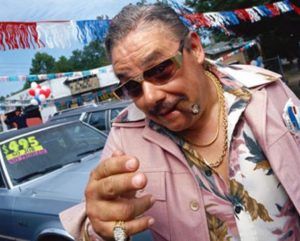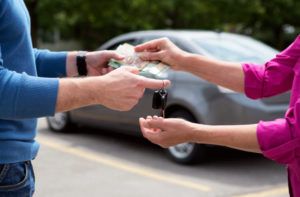Here’s Part 3 of the most kick-ass car buying guide: buying a USED car.
This part should be the most important to people who want to stay out of debt, and still enjoy most of the benefits of having a decent car.
Just because it’s used it doesn’t mean you shouldn’t enjoy having a car just like a new one. Even more so, if I were you, I’d also bask in the glory of not being ripped off and paying for a depreciating liability that loses about a third of its value in the first year, if bought new.
So, let’s get going:
3. USED
Buying a used car comes traditionally in 2 flavours:
a) from dealer

i) in ensemble with a trade-in of your old car
ii) just purchasing the car
Please be aware that trading in your old car and purchasing another (used) one are TWO separate transactions.
That means two sets of documents, two negotiation discussions for these separate objects. Make no mistake about any ‘bundling’, and deals they might offer. For they often (if not always) do…
Just be aware that a dealer’s reason to exist is to make a profit on the cars they sell.
I hope it bears no explaining that that ultimately means they’ve bought it for less than they’re selling it to you. What they bought it for, is ultimately the car’s value.
Nothing wrong with them wanting to make a profit. Also, nothing wrong with you being informed and not letting them take advantage of you either.
All I’m saying is that it should be fair for everyone.
Alright, let’s get into the meat of the problem: this process revolves mainly around the finding and testing of a pool of cars that may or may not be just ‘prepared’ for a quick sale.
The finding bit is essentially the same as Part 2 – Buying a new car from a dealer, because it entails the exact same steps. except even more important this time around, because the car won’t be new, as in Part 2. The testing section, however, is a fair bit more comprehensive than you would perform on a new car:
- shopping around: narrowing down a shortlist of 3 make/model combinations of vehicle you can trust is not going to be a money sink
- homework: gathering information on vehicles, prices, dealerships, details, compiling a working swipe-file/dossier to make the decision far easier and logical
- test drive: and inspection of the car, from all angles, of all systems and subsystems of it, both as a whole and individually; if you have a trusted mechanic, buy him/her a six pack of beer and bring them along; if not, use this checklist that you can print and bring along for each of the vehicles you’ll be testing.
Note that this is not an exhaustive checklist by any means.
There are additional tests you can perform at no cost to either you or dealer to check more fundamental things, like wheel alignment, body being intact and fairly symmetrical, engine performance, etc.
- negotiation: harder to drive the price down in the case of a used car, but with enough information and grit, anyone can definitely do it. For instance:
- (optional) financing: not recommended at all for a used vehicle, unless it’s almost brand new (1-2 years, low mileage, but too high cost to buy in cash).Here are the must-do items:
- paperwork: make sure everything is in order:
- the car’s ownership record must be clean, no liens on it, not declared stolen etc.
- demand the service/maintenance history, as it’s a good indication of how that car was cared for, if at all; else you might be buying a lemon
- car check (carfax, NMVTIS, autocheck, etc.) record; only consider buying if it’s a clean record. If it’s a car that has been involved in accidents, vandalism, natural disasters and so on – only consider buying if it wasn’t anything major (bent frame, etc.) and only if you can drive the price low enough to offset whatever unclean history events it may have been through
- always do the math between the production year and number of kilometers / miles. If it has either too many or too few for its year (averages here), walk away from that shady stuff
b) from private seller
This is what I recommend doing eventually. However, if there isn’t enough supply of the make/model combos(which you’ve narrowed down in Part 1) that you’re after in your local market (or within driving distance), you should definitely consider used car dealerships as well.
You want to go through the same steps as above (buying a used car from a dealer) even in the case of a private transaction. No point in repeating them here for the private part. Except with the extra added steps for:
- handling money
- if cash, never bring the whole amount, just a teaser amount. In case you get mugged or anything. You can always go together with the seller in a bank, and get some money out. In any public place, of course. Which leads me to:
- bring someone with you, preferably 1-2 friends. That will deter opportunity nasty business from your seller.
- do NOT exchange money until the paperwork is completed and signed by both parties, and validated by the (transportation) authority in your region, which leads me to:
- car documents transfer
- you validate the documentation of the car (ownership documents, service history, etc) before becoming the proud owner of a stolen vehicle, or whose documents have been altered, falsified. You should give a quick call to a random service from the service history of the car, and verify that it has actually been there, and they have records of it)
- of course some of the documents you need to demand are the verified history of the vehicle. Carfax.com or similar organizations that provide it. Normally the seller will support this cost, but even if they don’t, for your peace of mind, you should definitely go for it our of pocket, if that’s the only option
- slightly different negotiation attitude
- bring homework along, and kindly point out any excess pricing on the seller part compared to what the market is, and how much choice is there. Also, you will use this to partially justify your price counteroffers to his original asking price
- be extra nice and polite (private individuals are not doing this as a job, don’t waste their time unnecessarily; don’t abuse their car during the tests; always ask before performing any maneuver or test)
Now, armed with all this information, go forth and get yourself an awesome used car. Enjoy the magnificent benefit of having paid half price. For arguably the same car your friends the Joneses are now in debt for 7-10 years over. For the double the money you paid for yours. Fun!
Take good care of it. Keep it serviced and maintained regularly. And if you picked one of the reliable makes/models out there with decades-long proven track record – it will take care of you consistently 🙂
By the way, feel free to disagree in the comments section. Or let me know if I missed anything.

